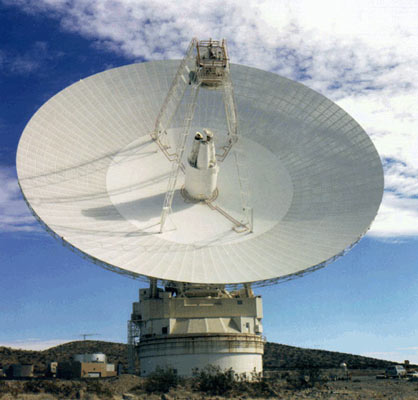One reason we need to re-think our communications strategies is that our resources are so limited. The Interplanetary Internet Project, for example, points out as a major justification for its work that if we can network spacecraft in distant planetary environments, we can sharply cut back on the amount of antenna time needed. After all, having a trio of spacecraft (including an orbiter, perhaps, and two rovers) linking their data to a single relay would mean a unified data download to Earth.

The IPN idea would create new networking protocols that could make these things happen. But research continues on other fronts, including the technology we use to transmit signals. An upcoming paper discusses phased arrays, wherein a large number of mini-transmitters could send a combined beam into the sky. Systems like these are familiar to those working with military radar but have been hitherto unavailable for cost reasons for civilian uses. The paper, by Louis Scheffer at Cadence Design Systems (San Jose, CA) discusses the advantages of such phased arrays with comparisons to digital cell phone technology and a consideration of the steep savings offered by saving transmission time over the Deep Space Network’s huge dishes.
Image: The Goldstone antenna, a 70-meter-diameter (230-foot) dish capable of tracking a spacecraft travelling more than 16 billion kilometers (10 billion miles) from Earth. Can we find ways to make the Deep Space Network’s antennae more efficient and cost-effective? Credit: NASA/JPL.
From an American Geophysical Union press release:
Currently, planetary radars and distant spacecraft communications need transmitters with extremely high power, which has been accomplished by combining a strong microwave source with a large reflective antenna. This is now done with giant satellite dishes mechanically steered to a point in the sky. NASA’s Goldstone radar, for example, the agency’s sensitive, deep-space analysis radar, uses a 500 kilowatt transmitter and a 70-meter [230-foot] reflector for tracking asteroids that may collide with Earth. The large antenna is focused on only a small point in space at a time, and must be adjusted–and occasionally shut down–due to changing weather conditions. In addition, Scheffer points out that while almost all of the world’s largest antennas are used to both send and receive, the powerful transmissions severely hinder their ability to detect faint signals from space.
What Scheffer has in mind as an alternative is a large, flat array of transmitters controlled by computers and capable of sending a powerful beam in one or several directions simultaneously. Scheffer’s system is transmit-only, and thereby useful for spacecraft control while freeing up existing antennae to operate in receive-only mode. It leverages the mass-production technologies now common to all kinds of electronics to arrive at the conclusion that an antenna similar to Goldstone’s could be built for a quarter of the cost. Existing work in phased radar arrays makes this conclusion plausible.
Centauri Dreams‘ note: Scheffer talks about a phased communications array being used for asteroid research as we scan the skies for near-Earth objects. But he’s also willing to speculate on the potential for such arrays when it comes to SETI signals sent by us to nearby stars. The technologies for producing such signals are rarely discussed in SETI literature, but have an obvious bearing on the likelihood of other civilizations deciding to create them in the first place (are we, as some have speculated, a galaxy full of listeners with no one in the transmission business?)
The paper is Scheffer, L. “A Scheme for a High-Power, Low-Cost Transmitter for Deep-Space Applications,” slated to appear in Radio Science in its October issue (Volume 40).


How do i get access to send coded message like you send out. I have the destination and the frequency to use. Can you let me know if it can be done?
The Stars system distance is about 9000 light years.
thanks for your time
Paul, I’m sorry to tell you that the power requirements for a signal like that are far too large for any individual. The only way to do it is to use a major transmitter like the Arecibo site or a few planetary radar sites elsewhere in the world. In other words, a signal that would get through at a reasonable level (and thus be able to be received at such a distance) would require a great deal of money and a major facility.
How did astronaunts on the moon communicate with earth… was it radio what kind of frequency how did it transmit?
Definitely radio, Don, though I don’t know the frequencies off-hand. Maybe someone else can supply same.
Apollo used a variety of frequencies for the various links. They apparently also switched from VHF to UHF after departing Earth orbit. My own recollection is that they used frequencies in the range of 2 to 3 GHz. A quick web search shows suborbital frequency ranges from 250 to 300 MHz and once beyond that distance used frequencies between about 2.2 to 2.4 GHz. Many channels were used for the different links: Earth-to-orbiter, orbiter-to-Moon, Moon-to-Earth, and so on. Lots of folks on the ground, such as amateur radio operators with compatible equipment, listened in on them. Doppler effects would have shifted the received channels, especially at the higher frequencies.
I am surprised that the frequencey range was in the 350-300 ghz range for suborbital adn that the frequenceies were not attenuated at those levels too much. May be a silly question and i am sorry if it is, but what is the doppler effect please.
thank you, steve
s cole: MHz, not GHz.
Hi,
Could anyone explain the doppler effects and how this would of shifted the received channels?
Thanks